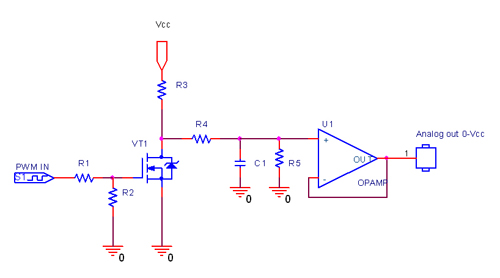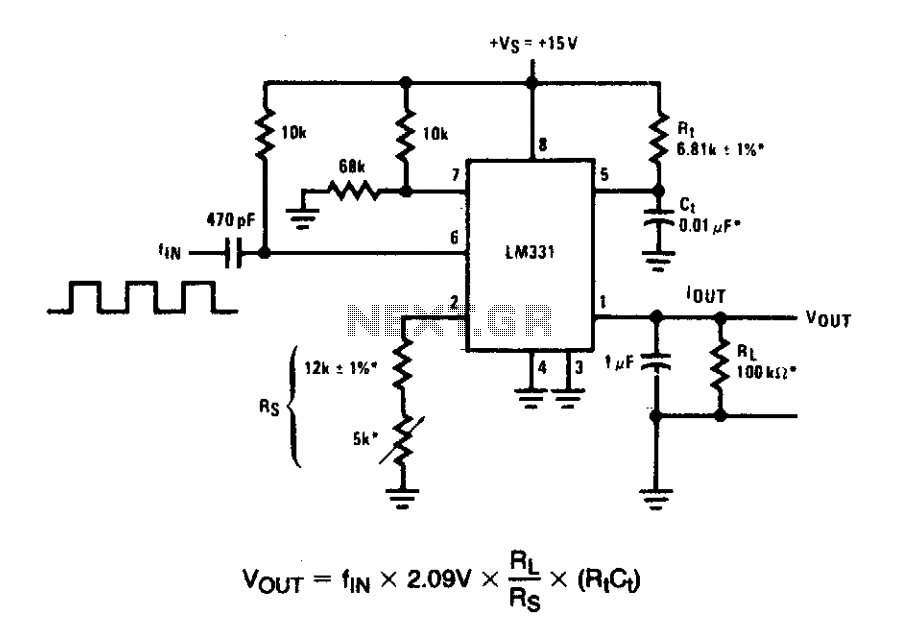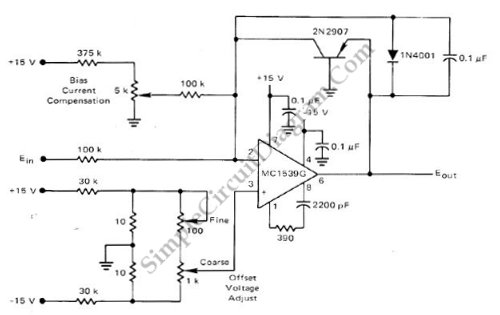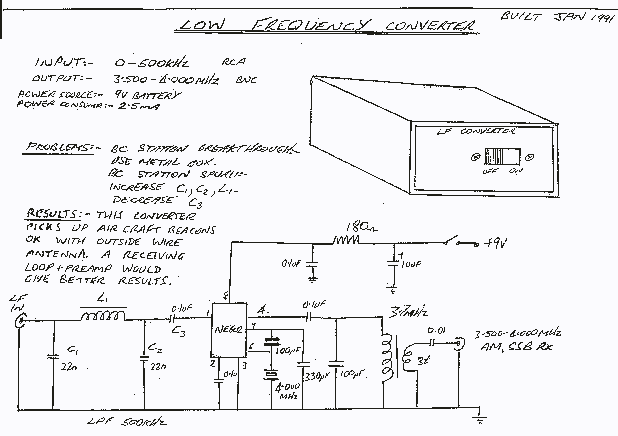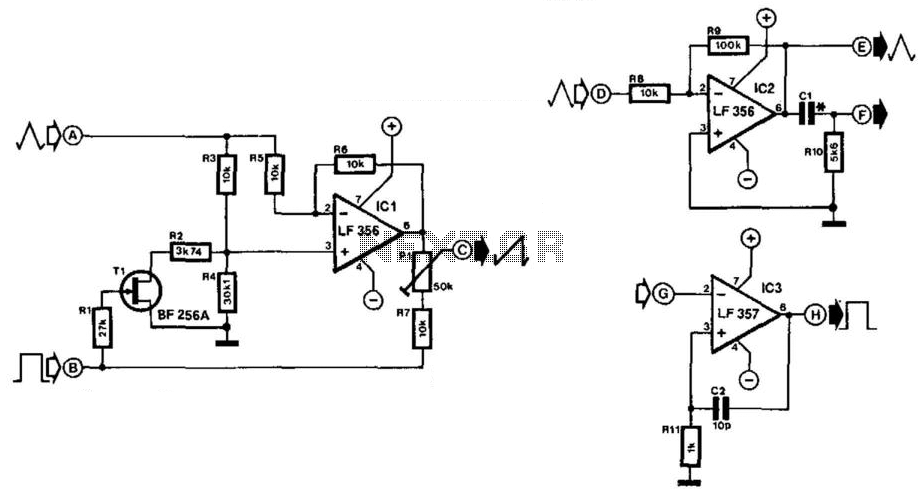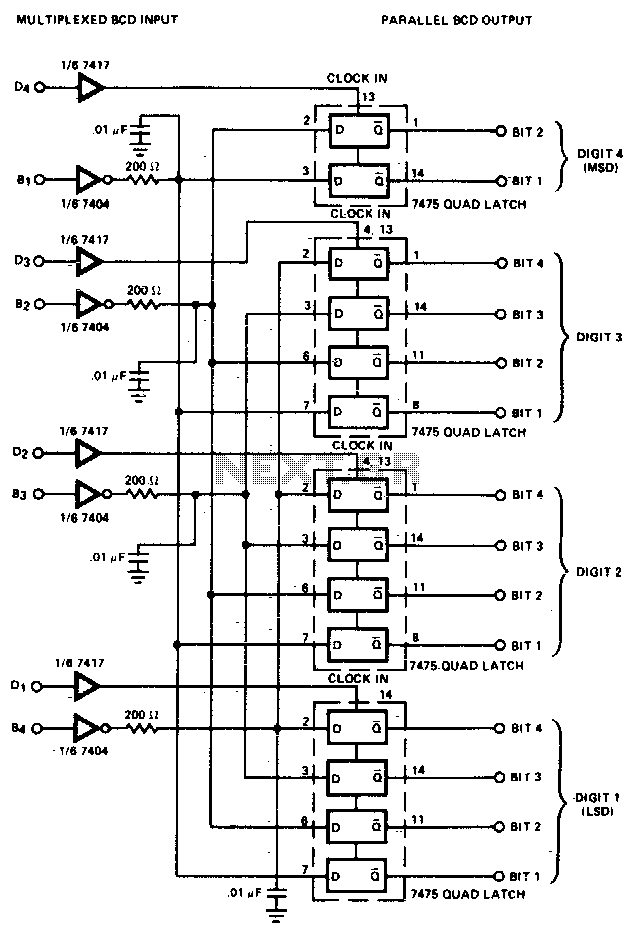
Vlf Converter
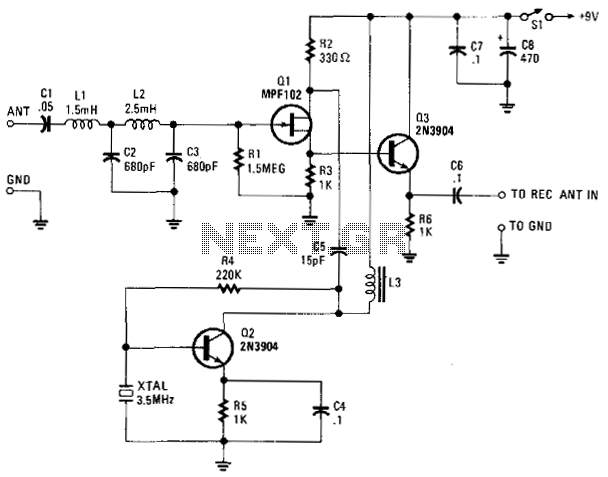
The VLF Converter is designed to receive signals for general coverage in shortwave receivers. It can pick up various unusual signals on frequencies below 15 kHz. This converter effectively transforms frequencies ranging from 0 to 250 kHz into a range of 3,500 to 3,750 kHz, allowing the reception of LF- and VLF-band segments on amateur or shortwave receivers that operate within 3,500 to 4,000 kHz. Signals are captured from a short whip antenna (8 to 10 feet) and are passed through a low-pass filter consisting of components L1, L2, C2, and C3 to RF amplifier Q1. Q3 then mixes these signals with a 3.5 MHz signal generated by Q2 and associated components C4, R5, R4, and a 3.5 MHz crystal oscillator (XTAL). L3 functions as an RF choke, providing an inductive load to Q3 and should be tuned to resonate slightly above 3.5 MHz when integrated into the circuit. An adjustable coil with a range of approximately 30 to 100 µH is recommended for this purpose. The output of the converter is taken from the emitter of Q3 through capacitor C6.
The VLF Converter circuit operates as a frequency translator, enabling the reception of very low frequency (VLF) signals by shifting them into a range compatible with standard shortwave receivers. The initial signal reception occurs via a short whip antenna, which captures low-frequency signals. These signals are filtered through a low-pass filter, comprising inductors L1 and L2 along with capacitors C2 and C3, which attenuates higher frequency noise and allows only the desired frequency range to pass to the RF amplifier Q1.
The RF amplifier Q1 boosts the strength of the filtered signal before it is mixed with a local oscillator signal generated by Q2. The mixing process occurs within transistor Q3, which combines the amplified VLF signal with the stable 3.5 MHz signal. The mixing results in the generation of intermediate frequencies that fall within the range suitable for the shortwave receiver.
The RF choke L3 is a critical component in this circuit, as it provides necessary inductive loading to Q3, ensuring optimal performance. It is important that L3 is tuned to resonate slightly above 3.5 MHz, which helps maintain the stability and efficiency of the mixing process. The adjustable coil allows for fine-tuning, accommodating variations in the circuit or antenna characteristics.
Finally, the output signal is extracted from the emitter of Q3 through capacitor C6, which serves to block any DC component, allowing only the AC signal to pass to the subsequent stages of the receiver. This design effectively enables the reception of a wide range of low-frequency signals, enhancing the capabilities of standard shortwave receivers in the process. The VLF Converter can be used to pick up signals for the general coverage of shortwave receivers. A number of unusual signals can be heard on frequencies below 15 kHz. This converter will convert frequencies from 0 to 250 kHz to 3 500 to 3 750 kHz so that the LF- and VLF-band segments can be received on an amateur or shortwave receiver that covers 3 500 to 4 000 kHz, Signals from a short whip antenna (8 to 10 feet) are coupled through low-pass filter L1/L2/C2/C3 to RF amp Ql. Q3 mixes these signals with a 3.5-MHz signal from Q2 and associated components C4, R5, R4, and 3.5-MHz XTAL.
L3 is an RF choke that presents an inductive load to Q3. It should be resonant somewhat above 3.5 MHz when placed in the circuit. An adjustable coil of about 30 to 100 should be sufficient. The converter output is taken from the emitter of Q3 through C6. 🔗 External reference
The VLF Converter circuit operates as a frequency translator, enabling the reception of very low frequency (VLF) signals by shifting them into a range compatible with standard shortwave receivers. The initial signal reception occurs via a short whip antenna, which captures low-frequency signals. These signals are filtered through a low-pass filter, comprising inductors L1 and L2 along with capacitors C2 and C3, which attenuates higher frequency noise and allows only the desired frequency range to pass to the RF amplifier Q1.
The RF amplifier Q1 boosts the strength of the filtered signal before it is mixed with a local oscillator signal generated by Q2. The mixing process occurs within transistor Q3, which combines the amplified VLF signal with the stable 3.5 MHz signal. The mixing results in the generation of intermediate frequencies that fall within the range suitable for the shortwave receiver.
The RF choke L3 is a critical component in this circuit, as it provides necessary inductive loading to Q3, ensuring optimal performance. It is important that L3 is tuned to resonate slightly above 3.5 MHz, which helps maintain the stability and efficiency of the mixing process. The adjustable coil allows for fine-tuning, accommodating variations in the circuit or antenna characteristics.
Finally, the output signal is extracted from the emitter of Q3 through capacitor C6, which serves to block any DC component, allowing only the AC signal to pass to the subsequent stages of the receiver. This design effectively enables the reception of a wide range of low-frequency signals, enhancing the capabilities of standard shortwave receivers in the process. The VLF Converter can be used to pick up signals for the general coverage of shortwave receivers. A number of unusual signals can be heard on frequencies below 15 kHz. This converter will convert frequencies from 0 to 250 kHz to 3 500 to 3 750 kHz so that the LF- and VLF-band segments can be received on an amateur or shortwave receiver that covers 3 500 to 4 000 kHz, Signals from a short whip antenna (8 to 10 feet) are coupled through low-pass filter L1/L2/C2/C3 to RF amp Ql. Q3 mixes these signals with a 3.5-MHz signal from Q2 and associated components C4, R5, R4, and 3.5-MHz XTAL.
L3 is an RF choke that presents an inductive load to Q3. It should be resonant somewhat above 3.5 MHz when placed in the circuit. An adjustable coil of about 30 to 100 should be sufficient. The converter output is taken from the emitter of Q3 through C6. 🔗 External reference
